Pearson Yachts Portal
Pearson sailboat table.


Table of All Models by Pearson Yachts
All sailboat models.
Listed by model name - click header field to sort by column.
| Model | Type | LOA | Draft | DISP | SA/D | Production | Designer | Links |
|---|---|---|---|---|---|---|---|---|
| Sailing Dinghy | 8 | 120/98 | 1958 | |||||
| | Full Keel | Stepped Cabin House Fractional | Yawl | 28.3 | 4.0 | 6930 | 14.5 | 1959–1967 (750 + 125) | Alberg | |
| | Centerboard | Kick-up Rudder | 16.3 | .6 | 3.6 | 575 | 28.5 | 1962–63 | Alberg | |
| | Catamaran | Fractional Rig | 17 | 585 | 1960 (162) | | |||
| | Full Keel | Fractional Stepped Cabin House | 22.5 | 3.0 | 3000 | 17.5 | 1960–65 (350) | Alberg | |
| | Keel/CB | Yawl | 37.7 | 4.5 | 7.7 | 15000 | 14.8 | 1960–1965 (33) | Tripp | |
| | Full Keel | Stepped Cabin House Yawl | Fractional Rig | 40.8 | 5.7 | 18800 | 15.7 | 1962–1968 (150) | Rhodes | |
| | Full Keel | Stepped Cabin House | 35 | 5.2 | 12600 | 15.8 | 1961–1967 | Alberg | |
| | Cat Rig | Centerboard | 12.1 | 5.2 | 286 | 1962 | Tritt | | Centerboard | 15 | 112 | 1960's | --> |
| | Full Keel | Fractional One-Design | 22.5 | 3.0 | 3000 | 18.8 | 1962–present (1793+) | Alberg | |
| | Full Keel | Stepped Cabin House | 25.5 | 3.8 | 5120 | 15.3 | 1962–1966 (440) | Alberg | |
| | Full Keel | Stepped Cabin House Yawl | 32.5 | 4.5 | 10300 | 16.0/17.5 | 1963–1967 (404) | Rhodes | |
| | Full Keel | 20 | 3.5 | 1800 | 17.6 | 1963 | Tritt | |
| | Modified Full Keel | 18 | 1000 | 32.5 | 1963 (50) | Tritt | | |
| | Full Keel | 26 | 3.4 | 5400 | 16.2 | 1964–1967 (351) | Alberg | |
| | Full Keel | Pilot House Ketch | 44.5 | 5.3 | 28000 | 13.6/12.7 | 1965–1970 | Alden | |
| | Keel/CB | Stepped Cabin House | 30.2 | 3.5 | 6.8 | 9800 | 14.7 | 1966–1971 (177) | Shaw | |
| | Full Keel | Flush Deck | 24.0 | 4.0 | 4300 | 18.9 | 1966–1968 | Shaw | |
| | Full Keel | Stepped Cabin House Yawl | 29.8 | 4.6 | 9500 | 15.0 | 1966–1970 | Shaw | |
| | Fin Keel | Stepped Cabin House | 27.2 | 4.3 | 6500 | 16.0 | 1967–1970 (173) | Shaw | |
| | Fin Keel | Fractional Rig | 22.3 | 3.5 | 2600 | 18.4 | 1968–1972 | Shaw | |
| | Full Keel | 23.5 | 4.0 | 4300 | 17.3 | 1968–1969 | Shaw | |
| | Full Keel | Pilot House | 30.3 | 3.5 | 10000 | 12.1 | 1969–1970 (few) | Shaw | |
| | Keel/CB | 35 | 3.8 | 7.5 | 13000 | 15.9 | 1968–1982 (514) | Shaw | |
| | Modified Keel | Sloop/Yawl | 42.8 | 6.5 | 21796 | 16.3/15.7 | 1968–1971 | Shaw | |
| | Fin Keel | Stepped Cabin House Weekender Package | 26.1 | 4.0 | 5400 | 16.7 | 1970–1982 (2100+) | Shaw | |
| | Fin Keel | One-Design | 26.1 | 4.0 | 5200 | 17.2 | 1970–1982 | Shaw | |
| | Fin Keel | Weekender | 26.1 | 4.0 | 5200 | 17.2 | 1974–1982 | Shaw | |
| | Keel/CB | 32.9 | 4 | 7.6 | 10900 | 16.0 | 1970–1975 | Shaw | |
| | Keel/CB | Yawl | 39.3 | 4.6 | 8.9 | 17000 | 16.5/18.8 | 1970–1977 (30) | Shaw | |
| | Fin Keel | 29.8 | 5.0 | 8,320 | 17.3 | 1971–1980 (1185) | Shaw | |
| | Keel/CB | Center Cockpit Flush Deck | 39 | 4.3 | 7.6 | 20600 | 15.2 | 1972–1973 (40) | Shaw | |
| | Fin Keel | Tall Mast | 36.5 | 6.0 | 13500 | 16.5/18.5 | 1972–1976 (103+) | Shaw | |
| | Fin Keel | Tall Mast | 33 | 5.9 | 12441 | 15.6/16.4 | 1973–1980 (236+) | Shaw | |
| | Modified Keel | Ketch/Yawl Center Cockpit | Aft Cabin | 41.8 | 5.3 | 21000 | 13.3 | 1975–1976 | Shaw | |
| | Fin Keel | 28 | 4.5 or 5.0 | 7850 | 16.0 | 1975–1982 | Shaw | |
| | Centerboard | Custom | 32.2 | 3.0 | 7.7 | 11643 | 1975 (one-off) | Shaw | | |
| | Modified Keel Sloop or Ketch | 36.4 | 4.5 | 17700 | 14.5 | 1976–1982 (400+) | Shaw | |
| | Modified Keel | 32.3 | 4.4 | 12800 | 14.0 | 1976–1983 (385) | Shaw | |
| | Fin Keel | Fractional | 31 | 5.5 | 9400 | 16.7 | 1978–1981 (65) | Shaw | |
| | Fin Keel | Keel/CB | 23 | 2.3 | 4.0 | 3500 | 16.5 | 1979–1985 | Shaw | |
| | Modified Keel | Cutter Ketch | Aft Cabin | 42.3 | 5.3 | 21000 | 15.2 | 1977–1985 (225) | Shaw | |
| | Centerboard | Flush Deck Double Spreader | 39.9 | 9.4 | 4.2 | 22800 | 16.0 | 1979–1981 | Shaw | |
| | Fin Keel | 31.7 | 5.5 | 9400 | 17.0 | 1979–1982 (113) | Shaw | |
| | Modified Keel | Pilothouse | 36.4 | 4.5 | 17500 | 13.6 | 1979–1981 (30) | Shaw | |
| | Fin Keel | Fractional Flush Deck | 29.9 | 5.8 | 6235 | 21.5 | 1981–1983 | Shaw | |
| | Modified Keel | Cutter | 36.5 | 5.5 | 17700 | 14.1 | 1981–1982 (49) | Shaw | |
| | Modified Keel | Keel/CB Cutter | Center Cockpit Double Spreader | Yawl Aft Cabin | 53.6 | 5.9 | 6.8 | 43000 | 13.1 | 1981–1985 (30) | Shaw | |
| | Fin Keel | Double Spreader | 36.9 | 6.5 | 12800 | 18.7 | 1982–1986 (42) | Shaw | |
| | Fin Keel | Cat Rig | 23 | 4.0 | 3000 | 16.2 | 1983–1985 (42) | Shaw | |
| | Modified Keel | 30.3 | 4.3 | 10400 | 15.3 | 1983–1986 (100+) | Shaw | |
| | Fin Keel | CB Option | 33.8 | 5.9 | 3.8-7.6 | 11200 | 17.5/17.0 | 1983–1986 | Shaw | |
| | Modified Keel | Cutter Center Cockpit | Aft Cabin Ketch | 42.2 | 5.2 | 22000 | 14.7 | 1983–1987 | Shaw | |
| | Modified Keel | Center Cockpit Cutter | Aft Cabin | 38.3 | 5.5 | 20575 | 13.0 | 1984–1986 | Shaw | |
| | Modified Keel | Cutter Tall Mast | 38.3 | 5.5 | 16915 | 16.6 | 1984–1985 | Shaw | |
| | Fin Keel | Keel/CB | Wing Double Spreader | Aft Cabin | 36.5 | 6.5 | 4.5 4.2-8.3 | 15000 | 17.4 | 1985–1990 | Shaw | |
| | Wing Keel | Aft Cabin | 26.9 | 3.3 | 5800 | 16.4 | 1986–1991 | Shaw | |
| | Centerboard | 17.9 | 4.1 | 800 | 1984–1985 | | ||
| | Daggerboard | 21.3 | 4.7 | 1.4 | 1700 | 24.77 | 1984–1985 | | |
| | Fin Keel | Shoal Keel | 25 | 4.3 | 3.0 | 3750 | 17.08 | 1984–1985 | | |
| | Fin Keel | Shoal Keel | 27 | 5.2 | 3.1 | 6250 | 14.76 | 1984–1985 | | |
| | Fin Keel | Aft Cabin Shoal Draft Option | 28.5 | 4.8 | 3.5 | 7000 | 16.8/16.3 | 1986–1989 | Shaw | |
| | Fin Keel | CB Option Double Spreader | Aft Cabin | 32.5 | 5.9 | 3.6-7.0 | 11000 | 16.5/15.8 | 1986–1991 (166) | Shaw | |
| | Fin Keel | Keel/CB Double Spreader | Aft Cabin | 39 | 6.9 | 4.6-8.8 | 17500 | 17.1 | 1986–1991 | Shaw | |
| | Fin Keel | Double Spreader Wing Option | 30.8 | 5.6 | 4.0 | 10000 | 17.0 | 1987–1991 (268) | Shaw | |
| | Fin Keel | Wing Option Solent Rig | 37.4 | 4.7 | 16000 | 16.7 | 1988–1991 | Shaw | |
| | Fin Keel | Double Spreader Wing Option | 34.5 | 4.0 | 11500 | 17.3 | 1989–1991 | Shaw | |
| | Fin Keel | Double Spreader Aft Cabin | Wing Option | 37.5 | 4.8 | 15175 | 17.2 | 1989–1991 (21) | Shaw | |
Key to Sailboat Table
- Model: Pearson model name and link to line drawing.
- Type: Boat and Rig Attributes. All types are Bermuda rigged sloop, single mast with fore-and-aft sails, unless otherwise specified by Cat, Ketch, or Yawl.
- LOA: Length Over All, the maximum length of the hull, in feet, from stem to stern measuring parallel to the waterline. This does not include projections of pulpits or spars.
- Draft: Deepest extent of hull, typically bottom distance from waterline to bottom of keel.
- DISP: Displacement, the vessel's weight in pounds, calculated from the volume of water displaced by it.
- SA/D: The sail area to displacement ratio is a bench-mark to evaluate light air performance as well as heavy air conditions.
- Production: Approximate years and number produced.
- Designer: Yacht designer
- Links: Web-Page references. External sites open in new tab or window.
Specifications are approximate from Pearson Yachts.
Key to Designers
- Shaw – William H. Shaw joined Pearson Yachts in 1964 as Chief Architect, eventually running the entire Pearson Yachts Division of Grumman. During his tenure, he and his team designed over 50 different sail and power boats. Bill Shaw
- Alberg – Carl Alberg's successful career as a designer can be linked back to his partnership with Pearson Yachts and early fiberglass yacht construction. Carl Alberg
- Tripp – During the 1960s, William H. Tripp Jr. was one of America’s most successful yacht designers. Bill Tripp
- Rhodes – Philip L. Rhodes was a naval architect known for his diverse yacht designs. Philip Rhodes | Philip Rhodes Vanguard
- Tritt – Bill Tritt is a yacht builder with a keen interest in fiberglass as a material to use in boats and cars. Bill Tritt
- Alden – John G. Alden was an American naval architect and the founder of Alden Designs. John Alden
Fast Boats in Their Time
Click to enlarge
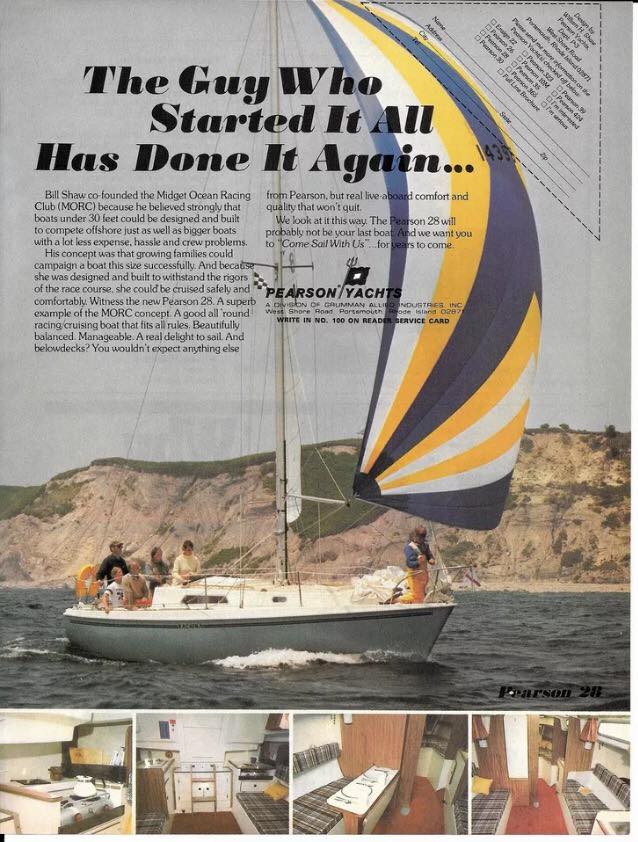
The guy who started it all has done it again...
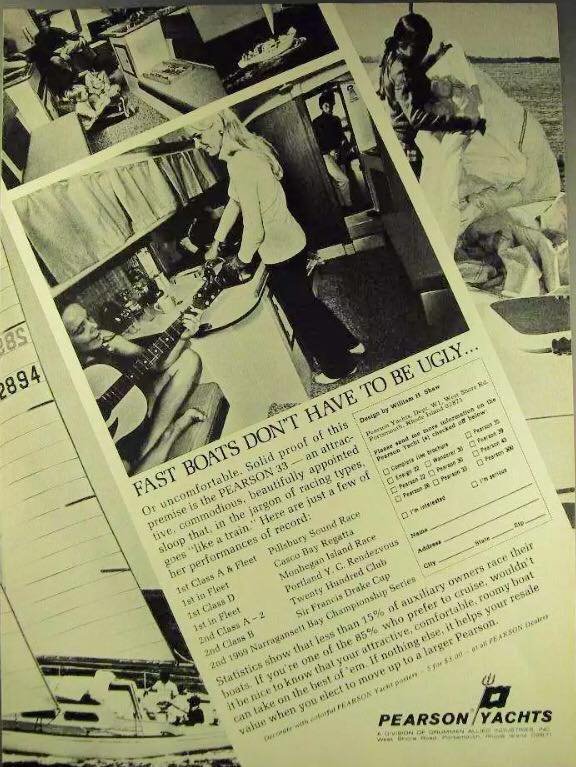
Fast boats don't have to be ugly...

- New Sailboats
- Sailboats 21-30ft
- Sailboats 31-35ft
- Sailboats 36-40ft
- Sailboats Over 40ft
- Sailboats Under 21feet
- used_sailboats
- Apps and Computer Programs
- Communications
- Fishfinders
- Handheld Electronics
- Plotters MFDS Rradar
- Wind, Speed & Depth Instruments
- Anchoring Mooring
- Running Rigging
- Sails Canvas
- Standing Rigging
- Diesel Engines
- Off Grid Energy
- Cleaning Waxing
- DIY Projects
- Repair, Tools & Materials
- Spare Parts
- Tools & Gadgets
- Cabin Comfort
- Ventilation
- Footwear Apparel
- Foul Weather Gear
- Mailport & PS Advisor
- Inside Practical Sailor Blog
- Activate My Web Access
- Reset Password
- Customer Service

- Free Newsletter

Maine Cat 41 Used Boat Review

CS 30 Used Boat Review
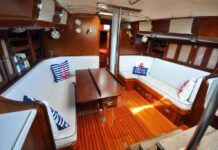
Hinckley 49 Used Boat Review
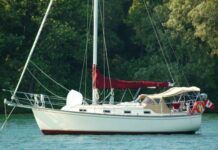
Island Packet 31 Used Boat Review

Best Crimpers and Strippers for Fixing Marine Electrical Connectors

Thinking Through a Solar Power Installation

How Does the Gulf Stream Influence our Weather?

Can You Run a Marine Air-Conditioner on Battery Power?

Master the Sailing Basics: Never Stop Learning the Little Things

How to Mount Your Camera on Deck: Record Your Adventures with…

Un-Stepping the Mast for America’s Great Loop

Headsails and Spinnakers: How to Explain Their Functions to a Beginner

Sinking? Check Your Stuffing Box

The Rain Catcher’s Guide

How to Change Your Engine Mounts
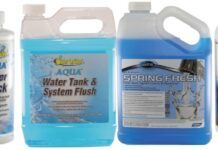
Keeping Water Clean and Fresh

Vinyl Boat Lettering DIY Application and Repair

Those Extras you Don’t Need But Love to Have

Three-Model BBQ Test

Alcohol Stoves— Swan Song or Rebirth?
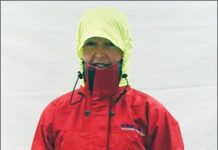
Womens Foul-Weather Gear

Preparing Yourself for Solo Sailing

How to Select Crew for a Passage or Delivery

Preparing A Boat to Sail Solo

Chafe Protection for Dock Lines

Waxing and Polishing Your Boat

Reducing Engine Room Noise

Tricks and Tips to Forming Do-it-yourself Rigging Terminals

Marine Toilet Maintenance Tips
- Sailboat Reviews
Pearson Triton
Possibly the world's cheapest long-range cruiser; where else could you get a boat like this for so little.
When cousins Clint and Everett Pearson took the first Pearson Triton to the 1959 New York Boat Show, they had no idea that ultimately they would build more than 700 hulls, the boat would establish Pearson Yachts as a premier builder of fiberglass boats, and that more myths would surround the Triton than practically any other boat of its time.
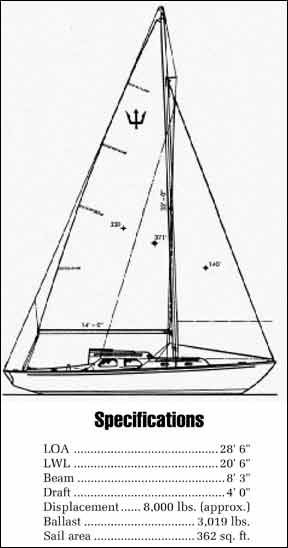
Returning to their Bristol, Rhode Island yard with 16 orders in hand, the success of the young company was assured.
We owned a Triton for a number of years, cruising it from the Great Lakes to the East Coast. Our affection has not blinded us, however, as ownership also exposed the boat’s several problem areas. In any case, this is a landmark boat that many good sailors cut their teeth on.
Myth: The Triton was the first production fiberglass sailboat auxiliary. Not true. The Rhodes-designed Bounty, built by Fred Coleman, owns that distinction.
The story of Pearson Yachts is well documented, so we’ll repeat here just the essentials. The company was founded in 1956 and built rowboats, dinghies and runabouts until the Triton arrived in 1959. A few were built in Sausilito, California, but the venture wasn’t to last long. During the next few years, Carl Alberg and Philip Rhodes accounted for more than half a dozen other designs, including the Vanguard, Alberg 35, Bounty II and Rhodes 41. The last Triton was launched in 1967.
In 1964 the company was bought by Grumman Allied Industries. Clint Pearson later left to start Bristol Yachts and later yet Everett departed to form a partnership known as Tillotson-Pearson. Bill Shaw emerged as the principal designer and later served as president. In 1990 Pearson went bankrupt and its assets were auctioned off. Aqua Buoy bought the molds but despite promises to resume production on a limited basis, no new boats have been built since. Blame the recession in part.
It’s a sad ending to what was once a very fine boatbuilding company. To this day, many of the early Pearsons are still sailing, and, to our mind, represent some of the best buys on the market.
The Triton is vintage Alberg—skinny, long overhangs, low freeboard, large mainsail and small foretriangle. Typical of boats designed to the CCA (Cruising Club of America) rule. Alberg was born in Sweden where people love skinny keelboats with long overhangs, such as the Folkboat. It is easy to trace the Triton’s lineage to such designs. Credit is also due to Tom Potter, of Jamestown, Rhode Island, who brought the project idea to the Pearsons, and had a hand in its development.
Many folks refer to the underbody as a full keel, but as a glance at the profile drawing shows, the forefoot is well pared away, and the rudder is located below the helmsman. The keel is long enough to provide excellent directional stability and minimize leeway. Still, there’s a lot of wetted surface by today’s standard.
There were so many changes made to the Triton over its nine-year production run, one could fill a book trying to mention every one. Displacement, for example, is listed at 6,930 pounds until the last year or so, when it was changed to 8,400 pounds. Like most boats, if you actually weighed them they’d probably come in all over the place. The ballast-to-displacement ratio of the lighter models is 44 percent, which coupled with the Triton’s fairly firm bilges, gives her plenty of stability.
An aesthetic problem of Alberg’s smaller designs is caused by the low freeboard; the cabin trunk, to provide headroom, is tall and rather ungainly looking. There’s six-foot-plus headroom in the main cabin, but the step in the coachroof reduces headroom forward to well below six feet.
The cockpit is long enough to lie down in, yet even when pooped (it happened to us), won’t hold enough water to threaten the boat. The bridge deck, which adds a measure of safety for offshore work, certainly helps. Some of the earliest boats had side-opening seat lockers, which are dangerous unless modified to seal tightly.
The original rig was a three-quarter fractional rig, however, a somewhat shorter masthead rig was later available, though it didn’t perform quite as well. A number of boats were built with yawl rigs (the main mast was shortened two feet and the boom one foot). The jumper struts on the fractional spars make the Triton easy to identify at a distance. The early Tritons were rigged with single lower shrouds, which proved inadequate. Richard Henderson, in his book, Choice Yacht Designs , reports that after about hull #120, double lower shrouds were standard and rigging kits supplied to owners of existing boats. We have several reports of rigging tangs failing; as with any old boat, we’d check the rigging carefully before subjecting the boat to much wind.
Despite the Triton’s tall cabin, she is an attractive boat, especially if viewed from the classic photographer’s position at the quarters or off the bows.
Construction
Myth: The hull of the Triton is an inch thick. Not true. Despite the fish stories of owners, the hull thickness varies from about 3/8-inch at the rail to perhaps 3/4-inch in the keel area. When you drill holes for transducers, you’ll be cutting through about 5/8-inch. Nevertheless, this is a good solid hull, though we have noticed, when examining hull plugs that some fibers were not completely wetted out.
Recently we heard from a former Triton owner in the Caribbean who lost his boat to Hurricane Hugo. Larger boats dragged down on it and carried it onto the beach at the St. Croix Yacht Club. “It finished up outside one boat,” he wrote, “inside two others and with another two on top. That magnificently built hull was completely intact, albeit with a few gouges. The deck had always been weak and it was penetrated by the intruders; in places it had parted from the hull, another soft area. We pumped it out, waterblasted it, and sold it to someone who patched it up, sorted out and resurrected the mast, and now lives on board.”
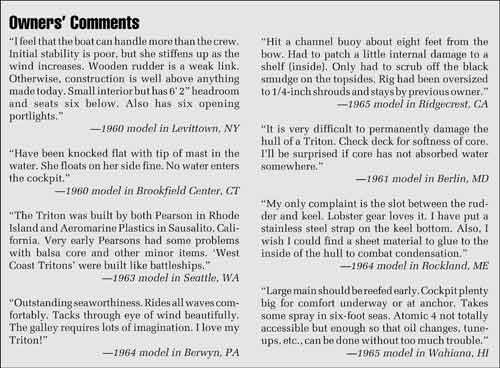
The Triton was built of conventional mat, cloth and woven roving, and polyester resin. Balsa core was used in the decks. Ballast, in boats after about hull #385, is cast lead lowered into the keel cavity and glassed over (which widened the keel two inches and deepened the draft about one inch). Voids in this area are commonplace. Water entering the cavity from a grounding theoretically should not enter the cabin, but repair is messy if straightforward. The earlier boats had external ballast. Which is better is the subject of constant debate. Internal ballast obviates the need for keel bolts, which are a source of concern and maintenance. On the other hand, grounding labor intensive.
Besides deck delamination, which is common to many old boats, a weakness of the Triton is insufficient load-carrying ability of the beams that support the deck-stepped mast. Because the walkway is on centerline, the main bulkhead and the one separating the head from the forward cabin cannot take all of the loads. A square beam was fastened to the forward bulkhead and run underneath the deck; it is supported at either end by beams that run down the bulkhead to the hull. Nevertheless, numerous owners report caving of the deck underneath the mast. Repair means unstepping the spar, removing the beams and replacing them with new, stouter materials. Not an easy job, but not too tricky either.
Any boat as old as the Triton (more than a couple of decades) cannot hope to retain its original gel coat. Most Tritons have been painted, a few may have been sprayed with new gel coat.
In looking at Tritons for sale, the quality of the paint job may be a decisive factor. A professional or well-done home job is probably worth paying a little extra for. Be wary of the amateur paint job in which the owner has prepped with a sander run amok: telltale little half-moons visible when the light is right.
Our late model Triton was delivered standard with a lightning ground system, bronze Wilcox-Crittenden seacocks and generally good quality hardware. The South Coast winches are out-of-date now, but still serviceable. A nice set of self-tailers would be a great upgrade, but they’re expensive. The spreader sockets are aluminum sand castings and can break without warning. Also check for electrolysis of the bronze rudder shoe.
The rudder was built of mahogany with bronze drift pins. Over the years the expansion and contraction of the wood (during haul-out) causes cracks to develop. Many owners have had to build new rudders, sometimes opting for fiberglass. A few have redesigned the rudders as well, usually by squaring and giving more depth to the trailing edge to help fight weather helm. This is the shape Alberg specified in a later redrawing of the Triton for Henderson’s book.
The Triton’s interior plan is simple. The 6′ 3″ settees in the main cabin double as sleeping berths. They are wider than normal, so it is often necessary to place a pillow behind your back for comfort. The head is private but small.
Furniture components are plywood covered with plastic veneer intended to look like teak. This makes for a dark cabin. You can paint the veneer, but it needs a good scuffing to hold paint, and will still chip. People have tried just about everything to get rid of it, including gluing mildew-resistant designer fabrics to the surfaces.
The sole is teak, supported by wooden, athwartship beams (“floors”). A wet bilge can cause these to rot, so inspect beneath the sole carefully.
The icebox also is built up out of plywood, with just an inch or two of styrofoam in the middle. Equally bad is its side-loading door. This method of construction and design won’t keep ice for long, and again, many owners have rebuilt theirs. Unfortunately, the original location doesn’t allow for much expansion, so you may need to relocate the box to the head of a settee. Any owner or prospective owner of a Triton should read Spurr’s Boatbook: Upgradingthe Cruising Sailboat , which details many of the modifications necessary.
Regarding the ice box, you’ll also note that there’s access to its upper shelf from the cockpit, which was a clever way of grabbing beers, but does nothing to help retain ice.
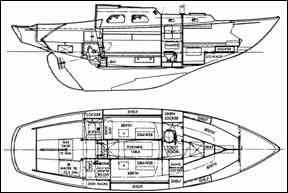
The early Tritons did not have a headliner anywhere inside. Later, a gel-coated fiberglass liner was added to the main cabin, which improves its looks enormously. The forward cabin, in all but the last Tritons, was unfortunately left bare. You may see the original, dreaded, speckled spray paint jobs there, but most owners will have painted it over.
The best feature of the Triton’s interior is the pair of forward-facing, opening portholes in the main cabin. These are situated at the step in the coachroof, and provide excellent ventilation down below as well as allowing you to see forward, a feature seldom found on other boats.
The 30-hp Atomic 4 was the standard powerplant, which provides more than enough power and easily drives the boat at hull speed—a little more than six knots. Access is not any better than any other boat of this size, but by removing the companionway ladder the front end can be worked on fairly easily. You’ll need your kid to tighten the stuffing box.
So many of these engines were built, and so many are still in service, we won’t bother to detail all the problems, solutions and repowering considerations attendant to the Atomic 4. Suffice to say that if you like tinkering with engines, the Atomic 4 is simple and can be successfully goaded to perform adequately. Some Tritons have been repowered, most often, we suspect, with Universal’s four-cylinder diesel, which was billed as a drop-in replacement. To the best of our knowledge, some modification of the engine beds still is required. A major problem, of course, is corrosion due to sea water cooling.
Performance in reverse, as with nearly all boats of this type with long keels and propellers in apertures, is unpredictable. But that has nothing to do with the engine.
Performance
The Triton is surprisingly quick for her short waterline, which when the boat is heeled, lengthens nicely.
The boat heels rapidly to about 15 degrees, then stiffens satisfyingly. It’s tough to push the rail under, though it can and has been done often. Water still won’t enter the cockpit.
The nice thing about this type of boat is that you can carry on over-canvased without stalling the rudder. Just luff the mainsail a bit and even the gusts won’t send you reeling out of control, as often happens with spade rudders. And it tracks well. Consequently, the Triton is a very forgiving boat, especially for the beginner.
Because of its large mainsail and small foretriangle, the boat has weather helm when carrying working sails. Better to carry a #2 genoa and reef the main. That way you’ll balance the sail plan better and find the helm easier to manage.
The PHRF rating of the Triton averages about 246. There aren’t many boats slower in the U.S.S.A. listings. For comparison, how about a Tanzer 22 or Venture 25? The Tartan 27, a S&S design of similar vintage, rates 228. These figures can be misleading, however. We recall sailing away from an entire fleet of Pearson boats during one of the builder’s rendezvous on Narragansett Bay. Whipping a Sabre 28 (PHRF—192) another day. Perhaps we were borne by some favorable and undetected current, which no doubt gives rise to those familar comments of “shows her heels to a lot of larger boats.”
In any case, the rating does allow for competitive sailing. We placed first and second in our only two PHRF races. And for cruising, which is her forte, speed is just fine for such a short waterline.
Prices of Pearson Tritons peaked in the early 1980s at about $18,000. Since then, their value has dropped along with practically every other boat. And, of course, they’re getting older, requiring more time and money to keep in shape or upgrade. Today you can buy a Triton for less than $10,000, which makes her a real bargain. (You’ll pay in the low teens for a good one.) We feel fairly confident in saying that it is the smallest, most affordable offshore boat you can buy. At least one has circumnavigated, Jim Baldwin in Atom . And we know of many others that have made safe trans-oceanic passages. You should consider fitting storm shutters to the main cabin windows, as they are on the border of being too large.
It’s too bad that Pearson is out of business, as they always had a good customer service department. Over the years we’ve obtained old parts from them, or referrals to the original suppliers, even foundries for bronze and aluminum castings.
If you’re on a budget and willing to do your own upgrading, the Triton at least gives you a solid structure as a starting point. Given the strength of the hull, devotion of owners, and active owner’s association (National Triton Association, 300 Spencer Ave., East Greenwich, RI 02818; (401) 884-1094) with active racing and rendezvous in most parts of the country, we fully expect to see the Triton well into the next century.
RELATED ARTICLES MORE FROM AUTHOR
I’m A ! Proud Owner of a 1966 Pearson Triton 29.5 Built on the East Coast and first purchased there I am the third owner! It is Docked in Oceanside Calif.
Hi Michael, I’d like to ask you some questions about your gas tank. I also have a 1966 Pearson Triton 28.5 and live in San Diego.

LEAVE A REPLY Cancel reply
Log in to leave a comment
Latest Videos
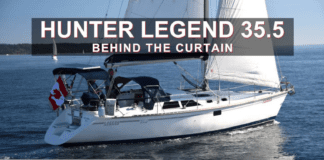
Hunter Legend 35.5 – Behind the Curtain

Whipping Line On Your Sailboat

Hallberg Rassy 42 – Behind the Curtain

The ICW – The Easiest Way – Sail to the Sun...
- Privacy Policy
- Do Not Sell My Personal Information
- Online Account Activation
- Privacy Manager
The Triton 25 is a 25.0ft masthead sloop designed by Gary Mull and built in fiberglass by Pearson Yachts since 1984.
The Triton 25 is a light sailboat which is a reasonably good performer. It is reasonably stable / stiff and has a low righting capability if capsized. It is best suited as a day-boat.
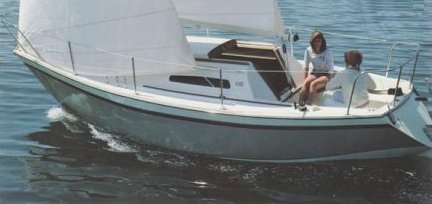
Triton 25 for sale elsewhere on the web:

Main features
| Model | Triton 25 | ||
| Length | 25 ft | ||
| Beam | 8 ft | ||
| Draft | 4.25 ft | ||
| Country | United states (North America) | ||
| Estimated price | $ 0 | ?? |
Login or register to personnalize this screen.
You will be able to pin external links of your choice.

See how Sailboatlab works in video
| Sail area / displ. | 17.08 | ||
| Ballast / displ. | 33.33 % | ||
| Displ. / length | 170.34 | ||
| Comfort ratio | 16.14 | ||
| Capsize | 2.06 |
| Hull type | Monohull fin keel with spade rudder | ||
| Construction | Fiberglass | ||
| Waterline length | 21.42 ft | ||
| Maximum draft | 4.25 ft | ||
| Displacement | 3750 lbs | ||
| Ballast | 1250 lbs | ||
| Hull speed | 6.20 knots |

We help you build your own hydraulic steering system - Lecomble & Schmitt
| Rigging | Masthead Sloop | ||
| Sail area (100%) | 257 sq.ft | ||
| Air draft | 33 ft | ||
| Sail area fore | 143.78 sq.ft | ||
| Sail area main | 113.40 sq.ft | ||
| I | 30.27 ft | ||
| J | 9.50 ft | ||
| P | 27 ft | ||
| E | 8.40 ft |
| Nb engines | 1 | ||
| Total power | 0 HP | ||
| Fuel capacity | 0 gals |
Accommodations
| Water capacity | 0 gals | ||
| Headroom | 0 ft | ||
| Nb of cabins | 0 | ||
| Nb of berths | 0 | ||
| Nb heads | 0 |
Builder data
| Builder | Pearson Yachts | ||
| Designer | Gary Mull | ||
| First built | 1984 | ||
| Last built | 0 | ?? | |
| Number built | 0 | ?? |
Modal Title
The content of your modal.
Personalize your sailboat data sheet
PEARSON 25 Detailed Review
If you are a boat enthusiast looking to get more information on specs, built, make, etc. of different boats, then here is a complete review of PEARSON 25. Built by Pearson Yachts and designed by undefined, the boat was first built in 1986. It has a hull type of Fin w/spade rudder and LOA is 7.62. Its sail area/displacement ratio 17.08. Its auxiliary power tank, manufactured by undefined, runs on undefined.
PEARSON 25 has retained its value as a result of superior building, a solid reputation, and a devoted owner base. Read on to find out more about PEARSON 25 and decide if it is a fit for your boating needs.
Boat Information
Boat specifications, sail boat calculation, rig and sail specs, contributions, who builds pearson 25.
PEARSON 25 is built by Pearson Yachts.
When was PEARSON 25 first built?
PEARSON 25 was first built in 1986.
How long is PEARSON 25?
PEARSON 25 is 6.53 m in length.
What is mast height on PEARSON 25?
PEARSON 25 has a mast height of 8.23 m.
Member Boats at HarborMoor

- Forums New posts Unanswered threads Register Top Posts Email
- What's new New posts New Posts (legacy) Latest activity New media
- Media New media New comments
- Boat Info Downloads Weekly Quiz Topic FAQ 10000boatnames.com
- Classifieds Sell Your Boat Used Gear for Sale
- Parts General Marine Parts Hunter Beneteau Catalina MacGregor Oday
- Help Terms of Use Monday Mail Subscribe Monday Mail Unsubscribe
info on a 1984 25' Pearson Pearson Triton?
- Thread starter Darrell
- Start date Aug 13, 2006
- Brand-Specific Forums
- Other Sailboats
I am having trouble finding any specs / reviews of the 25' 1984 Pearson Pearson Triton. Any info would be appreciated. Thanks, Darrell
Pearson Triton Specs Darrell:Have you tried the link to Pearsoninfo.net ?
thanks, but nothing there. yes, I have checked there. However the Triton model listed there, is the "original" Triton, and only applies to the years 1959 -1967. Unless I am not looking in the right place, I don't see any info there on a 25'Triton model, manufactured in 1984.
Pearson Triton I have a 27 foot 1984 Pearson Triton. It has a Volvo Penta engine. After researching the history of my boat I found that the hull was copied by US Yatchs. Pearson normally uses Yanmar engines in their boats. This information came from a Pearson dealer.
thanks for the info thanks for the info. This 25' model has an outboard motor, but I wasn't aware of the US Yacht connection. I wasn't sure why it was called a Pearson Pearson as well.
Triton Yachts by pearson Please dont get the original pearson Triton designed by Carl Alberg and brought to the New York boat show in Jan 1959; with the Triton series of the mid 80`s. The original Triton 28'was Pearson`s first cruising boat had an atomic 4 inboard and marked the beginning for Pearson. The Triton series were built from molds purchased from US yachts in the mid 80`s.US yachts were the makers of Buccaneer sailboats. At the time Pearson apparently past its heyday didnt want to develop new designs on their own. For more info on the 80`s Triton series go to Dan Pfieffer`s Pearson 26 web site/ Bob Fox 1975 P26w #76 Whitecap Marblehead MA
- This site uses cookies to help personalise content, tailor your experience and to keep you logged in if you register. By continuing to use this site, you are consenting to our use of cookies. Accept Learn more…

Responsive Pearson 25 Sailboat

(Not Available)
Make: Pearson Model: 25
LOA: 25 Beam: 8
LWL: 21.4 Draft: 4.3
Ballast: 1250 Lbs Displacement: 3750 Lbs
Rig and Sails:
This boat is a Sloop with a Mast-head Rig, and 257 sq. feet of sail area. She has 2 Sails, Including Main Sail, Genoa.
She has a Fin-keel. The Hull is Original Gel-coat, and is in In minor need of cosmetic work condition.
Evinrude Gas (Outboard) Engine, 9.9 horse power with Moderate Hours.
Outboard, Roller-furling, Anchor, Sails
For Cruising, Racing, and anything in between, the Pearson 25 is one of the most versatile mid sized sailboats out there. Because her sleek profile and low wetted surface make her a fast and responsive sailboat, while her efficient cockpit and cabin make her a pleasure to cruise overnight with. That means getting there faster and more comfortable. Built by Pearson Yachts, this superior design was first molded by US Yacht. The design became so popular that pretty soon she was being built by multiple shipyards. Also called the "Triton 25", Pearson Yachts set out to construct the best 25 footer to date. Down below, there is plenty of room to entertain, sleep, and accommodate your guests and crew. That means a full galley, dinette, and berthing for 5, makes the Pearson 25 perfect for weekend cruising the Long Island Sound. Her long-shaft, Evinrude Outboard makes the perfect balance of auxiliary power, and sail. If you are looking a responsive Sailboat cruise the Sound then look no further than the Pearson 25.
Contact Fred for arrangements and info: 347 927 3350
Or email for more details: [email protected]
Photo Gallery: Pearson 25

This listing Originated at Barronsmarine.com/boats-for-sale/ .
For questions on listings Call: (347) 927-3350 Email: [email protected]
Boats For Sale
Freedom 30 $14,500, swedish sloop $25,000, express cruising albin 27 will thrill you, why buy a nonsuch 33 sailboat, what makes pearson 10m so fast and strong, why sail essential o'day 28 cruiser, yankee dolphin 24 $7500, sea sprite 23 weekender $17750, a tall-rig catalina capri 22 can be yours, you can sport-fish party or live aboard carver 42, go exploring aboard a catalina 22 compact sailboat, well cared for cape dory 27 can keep you sailing, consider purchase of kalik 33 contention racer cruiser, a steady going albin 27 is a perfect family cruiser.

Posted 2024-06-10 13:42
Contact Information:
1984 Pearson 25 Sailboat - $3,500 (Hamlin)

QR Code Link to This Post
post id: 7755669891
posted: 2024-06-10 13:42
updated: 2024-07-09 17:20
♥ best of [ ? ]
refresh the page.
1984 Pearson 25 Sailboat - boats - by owner - marine sale - craigslist
1984 Pearson 25 Sailboat. NEW PRICE! 3,700# displacement; 1,250# lead keel; 8 foot beam; 4' 3" Draft Selling as I am downsizing. In the water ready for your test sail! Interprotect 2000 Barrier Coat...
Great choice! Your favorites are temporarily saved for this session. Sign in to save them permanently, access them on any device, and receive relevant alerts.
- Sailboat Guide
1985 25' Pearson 25
- Description
Seller's Description
1985 Pearson 25 with 8 HP Honda. Good shape.
Rig and Sails
Auxilary power, accomodations, calculations.
The theoretical maximum speed that a displacement hull can move efficiently through the water is determined by it's waterline length and displacement. It may be unable to reach this speed if the boat is underpowered or heavily loaded, though it may exceed this speed given enough power. Read more.
Classic hull speed formula:
Hull Speed = 1.34 x √LWL
Max Speed/Length ratio = 8.26 ÷ Displacement/Length ratio .311 Hull Speed = Max Speed/Length ratio x √LWL
Sail Area / Displacement Ratio
A measure of the power of the sails relative to the weight of the boat. The higher the number, the higher the performance, but the harder the boat will be to handle. This ratio is a "non-dimensional" value that facilitates comparisons between boats of different types and sizes. Read more.
SA/D = SA ÷ (D ÷ 64) 2/3
- SA : Sail area in square feet, derived by adding the mainsail area to 100% of the foretriangle area (the lateral area above the deck between the mast and the forestay).
- D : Displacement in pounds.
Ballast / Displacement Ratio
A measure of the stability of a boat's hull that suggests how well a monohull will stand up to its sails. The ballast displacement ratio indicates how much of the weight of a boat is placed for maximum stability against capsizing and is an indicator of stiffness and resistance to capsize.
Ballast / Displacement * 100
Displacement / Length Ratio
A measure of the weight of the boat relative to it's length at the waterline. The higher a boat’s D/L ratio, the more easily it will carry a load and the more comfortable its motion will be. The lower a boat's ratio is, the less power it takes to drive the boat to its nominal hull speed or beyond. Read more.
D/L = (D ÷ 2240) ÷ (0.01 x LWL)³
- D: Displacement of the boat in pounds.
- LWL: Waterline length in feet
Comfort Ratio
This ratio assess how quickly and abruptly a boat’s hull reacts to waves in a significant seaway, these being the elements of a boat’s motion most likely to cause seasickness. Read more.
Comfort ratio = D ÷ (.65 x (.7 LWL + .3 LOA) x Beam 1.33 )
- D: Displacement of the boat in pounds
- LOA: Length overall in feet
- Beam: Width of boat at the widest point in feet
Capsize Screening Formula
This formula attempts to indicate whether a given boat might be too wide and light to readily right itself after being overturned in extreme conditions. Read more.
CSV = Beam ÷ ³√(D / 64)
Also known as the TRITON 25. (formerly US 25/BUCCANEER 250). The molds for these yachts were purchased from US Yachts which had earlier purchased them from Bayliner Inc. (builder of the Buccaneer series of sailboats). How many were built besides the one shown in the manufacturers brochure is unknown.
This listing is presented by SailboatListings.com . Visit their website for more information or to contact the seller.
View on SailboatListings.com
Embed this page on your own website by copying and pasting this code.
- About Sailboat Guide
©2024 Sea Time Tech, LLC
This site is protected by reCAPTCHA and the Google Privacy Policy and Terms of Service apply.
Posted 2024-07-20 11:21
Contact Information:
Pearson 30’ Wanderer Free (Oyster Bay)

QR Code Link to This Post
post id: 7767909245
posted: 2024-07-20 11:21
♥ best of [ ? ]
refresh the page.
Pearson 30’ Wanderer Free - boats - by owner - marine sale -...
PLEASE LOOK AT THE PICTURES; WE PUT OUR BOAT IN THE WATER AND LOST OUR RUDDER 1966 Pearson Wanderer, all FIBERGLASS, and a much sought-after boat with a three-year-old rebuilt engine with low hours...

IMAGES
VIDEO
COMMENTS
Notes. Also known as the TRITON 25. (formerly US 25/BUCCANEER 250). The molds for these yachts were purchased from US Yachts which had earlier purchased them from Bayliner Inc. (builder of the Buccaneer series of sailboats). How many were built besides the one shown in the manufacturers brochure is unknown.
The Cal-Pearson 31 sailboat. Popular family racer/cruiser. The Triton 25, Triton Yachts most popular family cruiser, is a roomy, trailerable package which features sleeping accommodations for five, a fully enclosed head, an efficient galley and a convertable dinette.
A comprehensive table of all sailboat models built by Pearson Yachts. Pearson Yachts Portal. Home; History; Sailboats. Table of Sailboats; Models up to 21' Plebe 8; Petrel 12; Hawk 16; Tiger Cat 17; Pearson T-18; Packet 18; Pearson T-21; Resolute 20; Models 22'-25' Pearson 22; ... PEARSON T-25. Pearson T-25
Pearson 25 is a 25′ 0″ / 7.6 m monohull sailboat designed by Doug Peterson and built by Pearson Yachts starting in 1986. ... The higher a boat's D/L ratio, the more easily it will carry a load and the more comfortable its motion will be. The lower a boat's ratio is, the less power it takes to drive the boat to its nominal hull speed or ...
The Triton 25, also called the Pearson 25, is an American trailerable sailboat, that was designed by Gary Mull and first built in 1984. The design is out of production. ... The boat has a draft of 4.25 ft (1.30 m) with the standard keel and 3.0 ft (0.91 m) with the optional shoal draft keel.
Given the strength of the hull, devotion of owners, and active owner's association (National Triton Association, 300 Spencer Ave., East Greenwich, RI 02818; (401) 884-1094) with active racing and rendezvous in most parts of the country, we fully expect to see the Triton well into the next century. Darrell Nicholson.
The Pearson 25 is a 25.0ft masthead sloop designed by Doug Peterson and built in fiberglass by Pearson Yachts since 1986. The Pearson 25 is a light sailboat which is a reasonably good performer. It is reasonably stable / stiff and has a low righting capability if capsized. It is best suited as a day-boat.
1985 Pearson 25' Sailboat. Very good condition. Price REDUCED to $4999. Includes 2008 mainsail, 2008 Mercury 9.9 outboard, and 2011 cabin cushions and upholstery. ... This Pearson Pearson 25 : Added 30-Sep-2016 Pearson Sailboats Pearson 25s New York Pearsons. Featured Sailboats: Home. Register & Post. View All Sailboats. Search. Avoid Fraud ...
The Triton 25 is a 25.0ft masthead sloop designed by Gary Mull and built in fiberglass by Pearson Yachts since 1984. The Triton 25 is a light sailboat which is a reasonably good performer. It is reasonably stable / stiff and has a low righting capability if capsized. It is best suited as a day-boat.
Founded by cousins, Clinton and Everett Pearson. It was the 28′ TRITON sailing auxiliary that put the company 'on the map'. Before this they had been using the newfangled fiberglass construction materials to build dinghies and small power boats. At the request of Tom Potter, who worked for American Boat Building, the Pearsons set out to built a sailing auxiliary that would sell for under ...
If you are a boat enthusiast looking to get more information on specs, built, make, etc. of different boats, then here is a complete review of PEARSON 25. Built by Pearson Yachts and designed by undefined, the boat was first built in 1986. It has a hull type of Fin w/spade rudder and LOA is 7.62. Its sail area/displacement ratio 17.08.
4.25'. Outside United States. $4,000. Description: *PRICE REDUCED/PRICED TO SELL*. tranquility is an immaculate boat. the only reason for selling is I have bought a racer with a bit more waterline, and need to pay it off. this is the perfect boat for a sailor who wants a lot of room for a young family getting in to sailing for first time.
In 1984-85 Pearson Yachts sold a line of sailboats that it called the Tritons. This was an attempt to capitalize on the success and reputation of the Alberg designed TRITON, introduced in 1958, and the company's best known model. ... The TRITON 25 is similar to the earlier US 25 and BUCCANEER 250 and was also sold as the PEARSON 25.
The original Triton 28'was Pearson`s first cruising boat had an atomic 4 inboard and marked the beginning for Pearson. The Triton series were built from molds purchased from US yachts in the mid 80`s.US yachts were the makers of Buccaneer sailboats. At the time Pearson apparently past its heyday didnt want to develop new designs on their own.
Her long-shaft, Evinrude Outboard makes the perfect balance of auxiliary power, and sail. If you are looking a responsive Sailboat cruise the Sound then look no further than the Pearson 25. Contact Fred for arrangements and info: 347 927 3350. Or email for more details: [email protected].
Some of the best-known Pearson models now listed include: 424, 303 Pearson, 31-2, 36-2 and 323 Pearson. Various Pearson models are currently offered for sale by specialized yacht brokers, dealers and brokerages on YachtWorld, with listings ranging from 1963 year models up to 2024. Find Pearson boats for sale in your area & across the world on ...
A number of changes were made during a very long production run. The PEARSON 26 WEEKENDER (or PEARSON 26W) has a longer cockpit and shorter coach roof. With a few very rare exceptions, all PERSON 26's have outboard wells and rely on an outboard motor for auxiliary power. Some boats were built at League City, TX (USA).
Pearson preowned sailboats for sale by owner. Pearson used sailboats for sale by owner. Home. Register & Post. View All Sailboats. Search. Avoid Fraud. ... 25' Atlantic Yacht Services aka Trump 25 Margaret D Lyme, Connecticut Asking $17,500. 42' Whitby 42 Ketch Kemah, Texas Asking $79,500.
1985 Pearson 25' Sailboat. Very good condition.Includes 2008 mainsail, 2008 Mercury 9.9 outboard, and 2011 cabin cushions and upholstery. Also includes jib, 168% genoa, spare mainsail and tiller. ... This Pearson Triton 25 : Added 04-Mar-2020 Pearson Sailboats Pearson 25s New York Pearsons. Featured Sailboats: Home. Register & Post. View All ...
1984 Pearson 25 Sailboat. NEW PRICE! 3,700# displacement; 1,250# lead keel; 8 foot beam; 4' 3" Draft Selling as I am downsizing. In the water ready for your test sail! Interprotect 2000 Barrier Coat and VC-17 anti-fouling Good shape. Cabin needs TLC. Cushions included. Yes, there is a tiller. Removed for winter covering. 9.9 Mariner (Mercury) ob
This ratio assess how quickly and abruptly a boat's hull reacts to waves in a significant seaway, these being the elements of a boat's motion most likely to cause seasickness. Read more. Formula. Comfort ratio = D ÷ (.65 x (.7 LWL + .3 LOA) x Beam 1.33) D: Displacement of the boat in pounds; LWL: Waterline length in feet; LOA: Length ...
1966 Pearson Wanderer, all FIBERGLASS, and a much sought-after boat with a three-year-old rebuilt engine with low hours This particular boat normally sells for around $10,000, but because I was diagnosed with a vertigo condition and was losing my balance from old age we put it on Craigs for $1,000.
32.5' Pearson Vanguard Bishops Marina Clubfoot Creek off Neuse River, North Carolina Asking $25,500
Pearson preowned sailboats for sale by owner. Pearson used sailboats for sale by owner. Home. Register & Post. View All Sailboats. Search. ... Sailboat Added 25-Aug-2015 More Details: Pearson 424 Ketch: Length: 42' Beam: 13' Draft: 5.3' Year: 1980: Type: cruiser: Hull: fiberglass monohull: